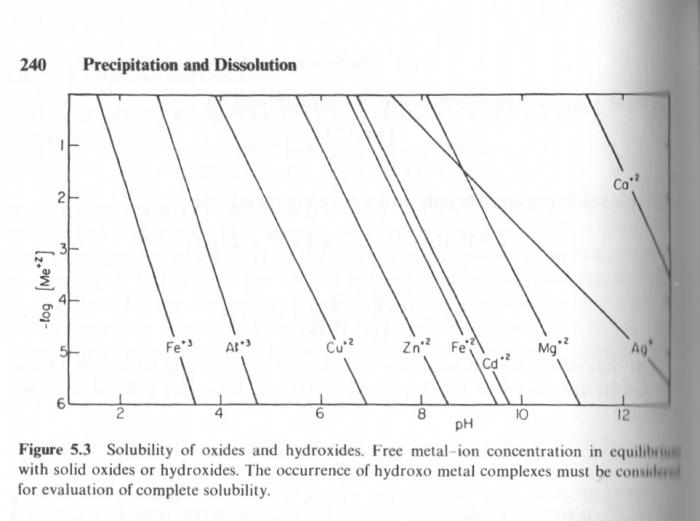I revert to my previous point about Ca2+ being a Lewis acid. I understand that it may not be so acidic as to complex water and form two hydronium ions and calcium hydroxide.
Calcium being a Lewis acid really doesn't have anything to do with it. Adding a Lewis acid to a solution does not necessarily result in a lowering of pH as would be the case with an Arrhenius or Brønsted-Lowry acid. In the example of a Lewis acid given in the Gold Book,
Me3B + :NH3 ---> Me3BNH3
Me3B is a Lewis Acid but in reacting with ammonia no protons are released and the pH isn't lowered. What is significant with calcium is that it form adducts with the anions of certain acids and in so doing releases the protons from those acids. It is these protons that are responsible for mash pH reduction. Among these acids are water, phosphoric acid and its monobasic and dibasic anions, carbonic acid and the bicarbonate ion, protonated side chains on proteins and who knows what else in a mash. The release of protons has nothing to do with the acidity or basicity of calcium but rather with the solubility of the adducts.
In
Ca++ + 2H2O = 2H+ + Ca(OH)2
we don't care a fig about what kind of acid Ca++ may be nor whether indeed it is an acid at all. All we care about is that it can pull the anions off the water leaving protons. The source of the protons is the water. Apparently chemists sometimes extend the definition of an acid to include substances that have this property in combination with water so that Ca++ + 2H2O is considered an acid in the Brønsted - Lowry sense. It 'dissociates' to yield protons. And there is an equilibrium constant for this but that equilibrium constant is not a dissociation constant in the usual sense of the word but related to the solubility product. If the solubility product of Ca++ and OH- is exceeded then the reaction above takes place and hydrogen ions are released. This happens when log[Ca++] > 22.8 - 2pH IOW it doesn't happen with beer.
A similar reaction takes place with bicarbonate ion
HCO3- + Ca++ --> H+ + CaCO3
and another similar one with monobasic phosphate
10Ca++ + 6HPO4- + 2H2O --> Ca10(PO4)6(OH)2 + 14 H+
We don't care about the reaction mechanism of these either. We care how soluble the adducts are. The least soluble will determine whether any protons are released or not. Apatite is the least soluble and so determines whether any protons will be available from this source. One can solve a system of 9 simultaneous non linear equations in an attempt to predict how much, if any, acid is released from this source depending of the available calcium and phosphate but that's a pretty tall order.
It is acidic enough, however, to complex phosphates and other anions at much lower concentrations than hydroxide at mash pH.
I don't think acidic is the term we want here. What is really at issue is the solubility of the adducts. The other point is that binding to the anion does not release protons. The acid must be present i.e.
Ca++ + CO3-- --> CaCO3 no proton
Ca++ + HCO3- --> H+ + CaCO3 proton.
These anions are basic and by removing them, they can no longer bind to H+.
But they always come from an acid. By taking them out you upset the equilibrium between the fully deprotonated anion and the one-less-deprotonated anion causing conversion with freeing of protons.
So while the carbonate of CaCO3 should absorb as many protons as the carbonate in K2CO3, potassium won't appreciably bind phosphate, and therefore, while the carbonate in calcium carbonate is counteracted by the reduction of other basic anions, the carbonate in potassium carbonate should not be.
The mechanism when a calcium or magnesium base is added is that the calcium precipitates as apatite releasing protons some of which immediately neutralize the base producing water. The extent to which this takes place depends on the pH, among other things. If carbonates are involved things get ever stranger because of the slow reactions (again depending on pH). I did some experiments for the Palmer/Kaminsky book and think I found that calcium carbonate and hydroxide were about 30% as effective as KOH on a per equivalent basis. There is discussion of all this in Chapter 6.
I may have missed something in your posts. As I said, I was reading everything on my phone, and I tend to miss things that way. I will go back and double check, but unless I find something that changes my mind here, I still say it should take fewer carbonate ions to raise the pH the same amount using potassium carbonate than it does calcium carbonate.
Let's say less hydroxyl ions from potassium hydroxide than hydroxyl ions from calcium hydroxide because of the apaptite effect. When carbonates get into the picture things are just too strange. We advise against the use of carbonate in any form but find lime (Ca(OH)2) to be fine as long as one is aware that its 'efficiency' is less than the stoichimetry might suggest.


